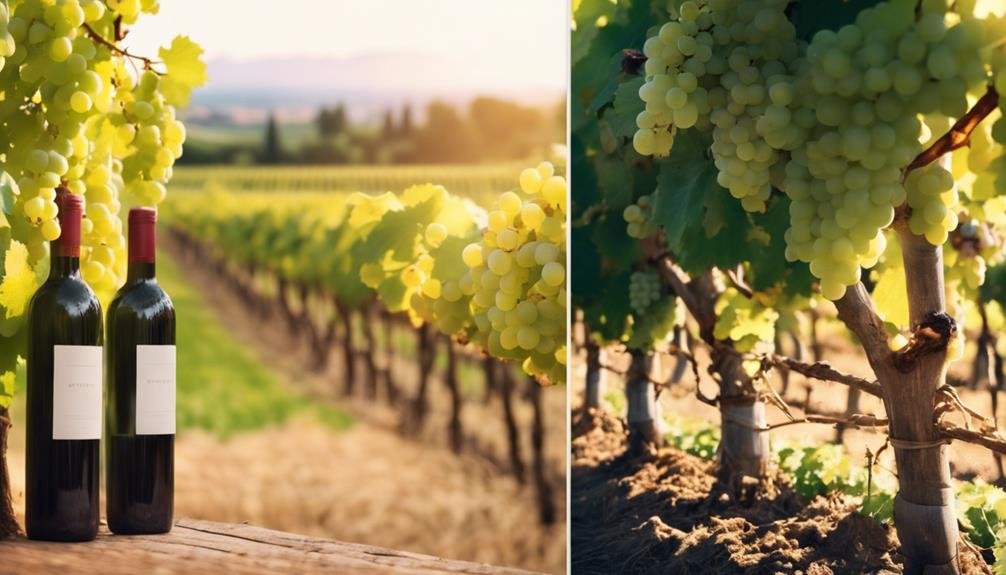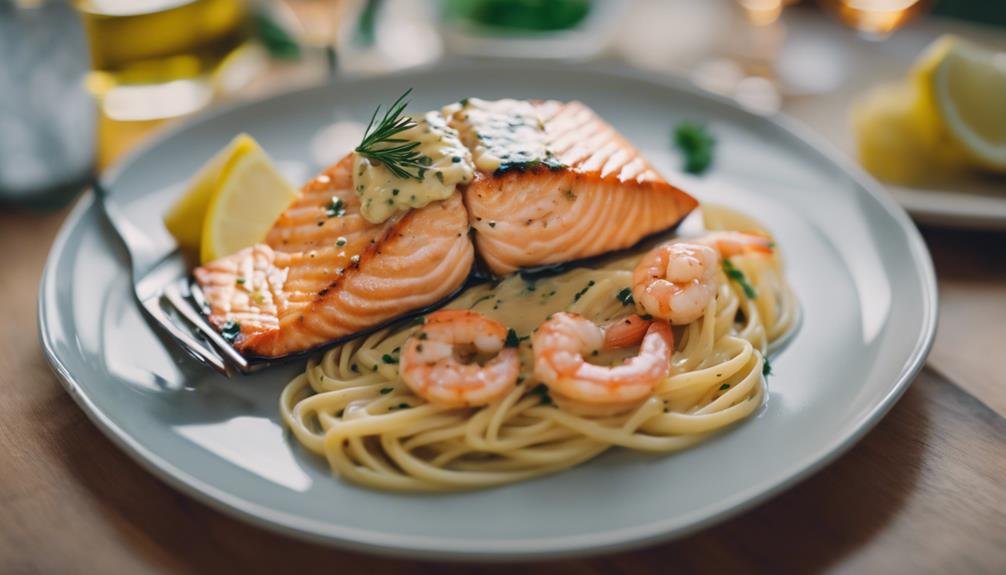Pinot Gris and Pinot Grigio, originating from Italy and France, display unique differences. Pinot Gris, thriving in cooler climates, offers honeyed notes and fleshy textures. In contrast, Pinot Grigio, preferring warmer conditions, presents fruitier flavors like lime, lemon, and pear with crisp acidity. French Pinot Gris is richer and more complex, while American Pinot Grigio showcases exaggerated fruit flavors. Winemaking techniques and regional influences shape their distinct qualities, from acidity levels to flavor profiles. Pair Pinot Grigio with light seafood and Pinot Gris with roasted chicken for delightful matches. Discover more about these intriguing wine varieties.
Historical Origins and Grape Characteristics
The historical origins and grape characteristics of Pinot Gris and Pinot Grigio trace back to regions in Italy and France, reflecting their cultural significance and crucial flavor profiles.
In these regions, soil influences and grape origins play a crucial role in shaping the grapes' characteristics. The climate impact and cultivation techniques further contribute to the unique qualities of these wines.
Pinot Gris, known for its full-bodied texture and complex flavors, thrives in cooler climates, while Pinot Grigio, with its invigorating acidity and lightness, prefers warmer conditions.
Understanding the historical roots and grape attributes of these wines provides insight into their diverse flavor profiles and the influence of terroir on their cultivation and production.
Flavor Profiles and Aromas
Exploring the intricate nuances of flavor profiles and aromas in Pinot Gris and Pinot Grigio reveals a rich tapestry of sensory experiences unique to each varietal. Pinot Grigio presents tasting notes of lime, lemon, pear, nectarine, and apple, with the occasional hint of honeyed notes and minerality. Its flavor nuances offer a crisp acidity and a weighty feel on the palate, distinguishing it in blind tastings.
French Pinot Gris, on the other hand, is characterized by fleshy textures and honeyed notes, providing a different sensory experience. American Pinot Grigio tends to showcase exaggerated fruit flavors, adding another layer to its aroma complexities. These distinctions in flavor profiles and aromas contribute to the diverse appeal of Pinot Gris and Pinot Grigio among wine enthusiasts.
Regional Variations and Winemaking Styles

Regional nuances and distinct winemaking methods greatly influence the characteristics of Pinot Gris and Pinot Grigio varietals. Terroir influences, including soil composition and climate, play a significant role in shaping the flavor profiles of these wines.
For example, Italian Pinot Grigio tends to be light, crisp, and acidic, reflecting the cooler climates where the grapes are grown. In contrast, French Pinot Gris often exhibits richer, more complex flavors due to the warmer growing conditions.
Fermentation techniques and aging processes further contribute to the unique qualities of each wine. While some producers may opt for stainless steel tanks to preserve freshness, others might choose oak barrels for added complexity and flavor development. These variations in winemaking styles result in a diverse range of expressions within the Pinot Gris/Grigio category.
Dryness Levels and Acidity
Amidst the diverse characteristics of Pinot Gris and Pinot Grigio wines, what distinguishes them significantly is their respective levels of dryness and acidity. Pinot Gris tends to be richer and more full-bodied compared to the lighter and crisper Pinot Grigio. This difference is primarily influenced by the grape ripeness at harvest and the winemaking techniques employed. Below is a comparison table highlighting the key variations in dryness and acidity between Pinot Gris and Pinot Grigio:
| Aspect | Pinot Gris | Pinot Grigio |
|---|---|---|
| Dryness | Medium to full-bodied | Light and crisp |
| Acidity | Moderate to low | High and invigorating |
When tasting these wines, note the varying levels of acidity that can influence the overall taste experience. In wine production, these differences are carefully managed to bring out the desired characteristics in each varietal.
Food Pairing Suggestions

When considering the culinary companions for Pinot Gris and Pinot Grigio wines, it's important to align their distinct flavor profiles with complementary food choices.
- Flavor Combinations:
- Pinot Grigio's citrus and pear notes pair excellently with light seafood dishes like shrimp scampi.
- Pinot Gris' honeyed and apple flavors harmonize with roasted chicken seasoned with herbs.
- Both wines can complement a cheese platter featuring brie, gouda, and aged cheddar.
Embark on culinary adventures by experimenting with different dishes to find the perfect match for your Pinot Gris or Pinot Grigio. Whether you opt for a delicate seafood pairing or a heartier meat dish, the versatility of these wines opens up a world of delectable possibilities.
Frequently Asked Questions
Are There Any Organic or Biodynamic Pinot Gris/Grigio Options Available?
When seeking organic or biodynamic Pinot Gris/Grigio options, inquire about sustainable farming practices and natural winemaking techniques. Look for vineyards committed to eco-friendly practices, ensuring a quality product aligned with environmental consciousness and purity.
Can Pinot Gris/Grigio Be Used in Cooking or in Sauces?
Delving into Pinot Gris/Grigio's culinary potential, its versatile nature enriches cooking. Explore its delicate flavors enhancing sauces, seafood, and poultry dishes. With a spectrum of pairing options, Pinot Gris/Grigio offers a culinary journey of taste and sophistication.
What Is the Ideal Serving Temperature for Pinot Gris/Grigio?
For Pinot Gris/Grigio, the ideal serving temperature ranges from 45-50°F. To enhance its flavors, chill the wine in the refrigerator for 2 hours. Serve in a white wine glass to appreciate its aromas fully. Pair with seafood, salads, and light pasta dishes.
Are There Any Specific Pinot Gris/Grigio Vintages That Are Highly Recommended?
Top rated vintages of Pinot Gris/Grigio include renowned years from Alsace and Oregon. Unique pairings to explore are Pinot Gris with herb-roasted chicken and Pinot Grigio with grilled shrimp. These combinations elevate the dining experience.
How Does the Aging Process Affect the Taste of Pinot Gris/Grigio Wines?
The aging process of Pinot Gris/Grigio wines can amplify flavors, especially with oak influence. Oak imparts vanilla, spice, and texture, enhancing the grape's natural characteristics. Over time, these wines evolve, showcasing complexity and depth in taste profiles.
Conclusion
To sum up, the differences between Pinot Gris and Pinot Grigio are as distinct as night and day, with each wine showcasing unique characteristics shaped by their origins and winemaking techniques.
Whether you prefer the vibrant acidity of Pinot Grigio or the rich complexity of Pinot Gris, there is a glass to suit every palate.
So, next time you're pondering which to choose, remember to savor the nuances that make these wines truly special.
